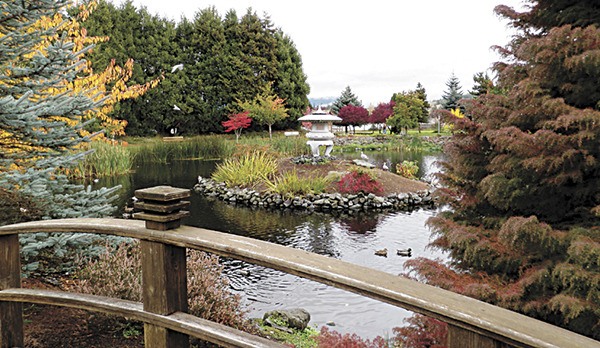Carrie Blake Park, Sequim’s largest, began as farmland at the east end of town. Now it’s a neighborhood of diverse attractions: two ponds, a Japanese garden, a gazebo, a picnic shelter, a convention center, two playgrounds, horseshoe pits, a dog park and agility training area, softball fields, a BMX track and a skatepark.
“It’s a surprise for a town this size to have a park this big,” said current park host Jerry Fryrear.
His co-host, and wife, Caecilia, added, “It’s unbelievably busy. And you see that this is not just a retirement community.”
And there is more to come, according to Parks and Recreation Board member Patsy Mattingley. In the next year or so, she said, the current road into the park will be closed off and a new entrance and parking area put in next to the skatepark, cutting down traffic through the center of the park.
“Right now,” Mattingley said, “it’s dangerous having the two playgrounds across a street from each other.”
The park has developed, Mattingley noted, because of the volunteer efforts of people with different interests. When community groups saw a need, she said, they invested time, money and hard work to make the park’s amenities possible.
Farm, roads, park
The park area once belonged to the 200-acre Honey Locust Farm, the home of Edward Blake.
In 1910, Edward Blake’s son, Charles, married Caroline Davidson, the daughter of Scottish settlers who farmed on Taylor Cutoff Road. The “Carrie” of the future Carrie Blake Park worked as a telephone operator for the Sinclair Hotel and the Port Williams single-circuit line. She joined her husband on the family farm; the couple kept a herd of 60 Guernsey cows, along with horses, pigs and gardens.
When U.S. Highway 101 was to be extended east to Blyn in 1934, the state transportation department began to mine gravel on the Blake property, creating what came to be known as “Blake’s ponds.” The ponds were mined for gravel for the next three decades. Meanwhile, Carrie Blake planted pond lilies and stocked the ponds with goldfish.
In the 1970s, Edward Blake sold about 28 acres bordering the ponds to the City of Sequim. The Sequim Lions Club asked the city to use the land as a park. Club members followed through by grading the land and building a meeting hall with a kitchen. Guy Cole Convention Center still hosts community events throughout the year.
The city purchased the ponds in 1975 and in the same year voted to name the park after Carrie Blake.
New gardens, new challenges
In 1993 the City of Sequim signed a sister city agreement with Yamasaki, Japan. Two years later the city set aside land in the park for a Japanese garden, to be constructed and maintained by the Yamasaki Sister City Committee. (Yamasaki joined five other cities to form Shiso City, and in 2004 Sequim entered into a sister city agreement with Shiso.)
Although Bell Creek is nearby, the park always has depended upon the city to pump in reuse water to fill its ponds and stream. Irrigation cuts in the summer of 1994 caused two of the park’s ponds to dry up and trap small fish behind wooden weirs. The Washington Department of Fish and Wildlife ordered the city to fix the problem. A $10,000 grant obtained by the Jamestown S’Klallam Tribe was matched by funding from the City of Sequim so that the department of public works could eliminate the two smaller ponds and deepen the two larger ones.
Best friends, skateboards
Like the rest of Carrie Blake Park, the Sequim Dog Park is an example of citizen action from beginning to end.
The first citizen action, in 2006, included several calls to the Sequim Police Department complaining that a few dog owners were running their pets off-leash at the Water Reuse Demonstration Park, next to Carrie Blake Park, early in the morning.
The police began watching the park, riling the dog owners. At Mayor Walt Schubert’s suggestion, dog owners petitioned the Park Advisory Board to build a dog park, studied design and safety issues, gathered signatures on a petition and went before the city council. In 2007, the city set aside nearly 2 acres on the east side of Carrie Blake Park and the “Dog Park Pals” raised money to create three fenced fields for dogs to go off-leash. The Sequim Police Department later set up an agility obstacle course to train its canine officers, opening the course to the community as well. With further donations from the Dog Park Pals, the city put up a shelter to keep the dogs’ human friends dry in wet weather.
The skateboard park was added in 2000. Under the guidance of Jeff Edwards of the public works department, local youths were offered free use of helmets at the park and a graffiti wall was added. Eagle Scout candidate Jeremy Cays built a helmet rack after a schoolmate was injured at the park. Currently the park is used by both skateboarders and bikers.
The lazy ponds and friendly ducks may make it seem that Carrie Blake Park always has been there, but both the landscape and the activities available are the result of energetic citizens who decided to serve the interests of the community.
Cathy Grimes and Patsy Mattingley contributed to this report; information also came from reports published by Harriet Fish, June Robinson and The Seattle Post-Intelligencer.



